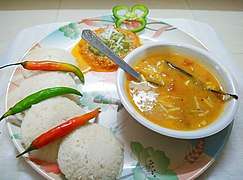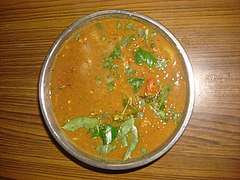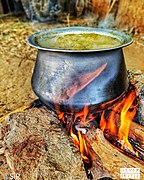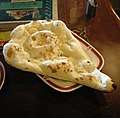Sambar (dish)
Sambar (IPA: sʌmbʌʀ, ISO 15919: Sāmbār), also spelled sambaar, is a lentil-based vegetable stew, cooked with dal and tamarind broth. It is popular in South Indian and Sri Lankan cuisines.
| Type | Stew or chowder |
|---|---|
| Place of origin | India |
| Region or state | South India, Sri Lanka |
| Main ingredients | Tamarind broth, lentils, vegetables |
History
According to food historian K. T. Achaya, the earliest extant mention of sambar in literature can be dated to the 17th century.[1]
Many historians believe that Sambar was invented by Tamil kings in the mid 1700s. However, some stories state that sambar was first made accidentally by the Maratha ruler Shivaji's eldest son Sambhaji, when he tried to make dal curry in the absence of his chef. He added tamarind to the dal, creating an early version of sambar that was hence named after him.[2]
Preparation

Sambar is made with one or more of these vegetables:
- okra
- moringa (better known as drumstick)
- carrot
- radish
- Winter melon
- potato
- tomato
- brinjal (eggplant)
- whole or halved shallots or onions.
Sambar often contains sambar powder, a coarse spice mix made of roasted lentils, roasted whole red chilies, fenugreek seeds, coriander seeds and sometimes asafoetida and curry leaves. Regional variations include cumin, black pepper, grated coconut, cinnamon, chana dal, urad dal, tur dal, or other spices.
The vegetables, tamarind pulp, sambar powder, turmeric, salt, and asafoetida are boiled together until the vegetables are half-cooked. Then the cooked lentils are added and allowed to cook until the vegetables are done. A spice-scented oil is added to the cooked sambar for extra flavor and tempering, and the dish is served garnished with fresh coriander leaves.
The addition of spice-scented oils, or tarkas, made by popping mustard seeds and curry leaves and other ingredients in hot coconut or vegetable oil, at the end of cooking is a common Indian culinary technique and is known as tempering. A combination of mustard seeds, black gram, dried red chillies, and curry leaves fried in ghee or coconut or vegetable oil is one example of numerous oil flavourings used for sambar. Some variations include additional ingredients such as cumin seeds, shallots, fenugreek seeds and asafoetida powder.
Some variations of sambhar include ingredients such as moong dal and pumpkin.
Variations
Sambar is part of a tradition of lentil-based vegetable stews in southern India. In regions that grow coconuts, notably some areas of Kerala, coastal Karnataka and Tamil Nadu, sambar is made with a paste of fresh, grated and roasted coconuts and spices, instead of sambar powder.
In Karnataka it is called saaru (called huli by the Brahmin community). This saaru is a speciality of Karnataka, especially the Old Mysore region. It is slightly sweeter due to the addition of extra tamarind to the cooked vegetables and lentils. The most common saarus are koli saaru and soppina saaru, with main ingredients chicken and greens respectively.
In Andhra Pradesh, it is called sambar. Apart from dal and tamarind, few vegetables are used in preparation, combination of few of these: onions, dosakaaya, bitter gourd, drum stick, okra, brinjal, pumpkin and tomatoes.
A similar stew, without lentils (but with vegetables, dried or fresh fish, or meat) is called kuzhambu in Tamil Nadu and pulusu in Andhra.
Serving
Sambar is usually served with steamed rice as one of the main courses of both formal and everyday south Indian cuisine. A two-course meal of sambar mixed with rice and eaten with some sort of vegetable side dish, followed by yoghurt mixed with rice, is a southern Indian staple.
Vada sambar and idli sambar are popular for breakfast or an evening snack in the south Indian states. Roadside restaurants often offer free refills of sambar for idli and vadas.
Sambar is also served as a side dish for dosa.
- Common sambar serving
 Sambar served with idli
Sambar served with idli Batata vada sambar
Batata vada sambar Coconut sambar
Coconut sambar Udupi Sambar powder (packed)
Udupi Sambar powder (packed) Chicken sambar, cooked in the traditional manner
Chicken sambar, cooked in the traditional manner
See also
- Cuisine of Andhra Pradesh
- Cuisine of Tamil Nadu
- Cuisine of Karnataka
- Kerala cuisine
- List of soups
- List of stews
- Udupi cuisine
- South Indian cuisine
References
| Wikimedia Commons has media related to Sambar (dish). |
- G. J. V. Prasad (2017). "Idli, Dosai, Sambar, Coffee: Consuming Tamil Identity". In Shweta Rao Garg; Deepti Gupta (eds.). The English Paradigm in India: Essays in Language, Literature and Culture. Springer Singapore. pp. 98–99. ISBN 978-981-10-5332-0.
- Mathai, Kamini (26 September 2014). "Sambar: the great Tamil dish of Maharashtrians". The Times of India. Retrieved 1 September 2019.


